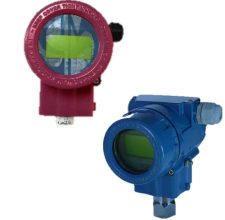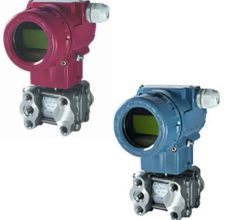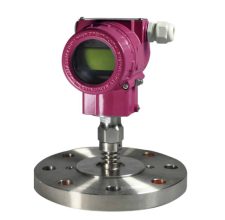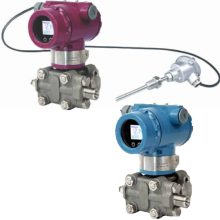Overview of Pressure Transmitters
The Smart Measurement ALDPT series of pressure transmitters are used for measuring process pressure, hydrostatic level, and liquid or gas volumetric or mass flow rates in all kinds of process applications. Within the ALDPT Series there are five different types of instruments to accommodate the wide variety of applications that exist in industry. SmartMeasurement’s staff of experienced application engineers is available to help users select among these choices and specify the instrument that provides the best solution for any pressure measurement application.
Featured Products
- Absolute & Gage Pressure
- 0~5800 psi (0~40 MPa)
- –4-752°F (-20- 400°C)
- ±0.5%, ±0.2%, ±0.075%
- Buna, Viton, PTFE
- SS #316L, Hastelloy C®
- 4~20mA DC, HART
- ½" NPT (F & M), M20*1.5 M, G½" M, Vacuum -DIN 28403 KF16 / ISO 2861
- Mounting brackets for 2" pipe, O2 cleaning, & capillaries (many fill fluids)
- Industrial process control
- Differential Pressure
- 0 ~2Mpa (290 PSI)
- –4-752°F (-20- 400°C)
- ±0.5%, ±0.2%, ±0.075%
- Buna, Viton, PTFE
- SS #316L, Hastelloy C®
- 4~20mA DC, SQR output, HART
- ½" NPT (F & M), M20*1.5 M, G½" M, Vacuum -DIN 28403 KF16 / ISO 2861
- 2, 3, or 5 way valve manifold for primary DP flow element (ACONE), mounting brackets for 2" pipe, O2 cleaning, capillaries (many fill fluids)
- Stand alone DP or use in conjunction with primary flow elements: Orifice, Venturi, ACONE, Pitot Tube, Wedge
- Differential Pressure Level
- 0 ~2Mpa (290 PSI)
- –4-752°F (-20- 400°C)
- ±0.5%, ±0.2%, ±0.075%
- Buna, Viton, PTFE
- SS #316L, Hastelloy C®
- 4~20mA DC, with keystroke and HART, Modbus
- Insertion 0-6" (0-150mm, ANSI up 1500# (1-4"), DN up to PN25 (25-100mm)
- 100:1 turn-down, security lock transmitter, capillaries (many fill fluids)
- Low cost tank level measurement
- Multi-variable Differential
- 0 ~2Mpa (290 PSI)
- –4-752°F (-20- 400°C)
- ±0.5%, ±0.2%, ±0.075%
- Buna, Viton, PTFE
- SS #316L, Hastelloy C®
- 4~20mA DC, SQR output, HART
- ¼”-18 NPTF & ⁷⁄₁₆"-20 UNF, drain at top, side or bottom of flange, or no drain
- 2, 3, or 5 way valve manifold for primary DP flow element (ACONE), mounting brackets for 2" pipe, O2 cleaning, capillaries (many fill fluids)
- HVAC / steam monitoring, building automation, oil & gas, any application where multi-parameter measurement is required, such as primary element flow metering
Why Choose a Pressure Transmitter
Pressure measurement is the most widely measured variable in industrial process control applications. Pressure measurement is commonly performed in applications involving all media phases including liquid, gas, and steam. For example, in the oil & gas industry, wellhead pressures are measured in subsea and topside locations. In water towers, pressure is measured to monitor and control water levels. Pressure sensors are used to monitor the water line pressure in automatic sprinkler systems. Barometric pressure is used to predict the weather.
Special Cases
The pressure transmitter plays an integral role in applications where flow, level, and temperature measurements are performed. A differential pressure (DP) transmitter can be used to measure both flow and differential pressure when used in conjunction with a primary flow element. They may also infer liquid level as a function of pressure differential in sealed, pressurized tanks. Some pressure transmitters also utilize temperature sensors to measure process temperature. This type of pressure transmitter may be used to calculate mass flows of compressible media such as steam and natural gas when used in conjunction with a primary flow element.
Benefits of Pressure Transmitters
Pressure transmitters offer numerous advantages across various industrial applications, making them indispensable in modern process control and monitoring systems. Here are some key benefits:
Accuracy and Reliability
Pressure transmitters provide highly accurate measurements, often within ±0.075% of the calibrated range. This precision is crucial for maintaining optimal process efficiency and product quality.
Versatility
From gauge pressure transmitters to differential pressure transmitters, these devices can measure various pressure types, adapting to diverse industrial needs.
Remote Monitoring
Pressure transmitters can send data over long distances, enabling centralized control and monitoring of multiple pressure points across a facility.
Durability
Modern pressure sensors are designed to withstand harsh industrial environments, including extreme temperatures, vibrations, and corrosive substances.
Cost-Effective
While initial investment may be higher than simpler pressure transducers, the long-term benefits of pressure transmitters often result in significant cost savings through improved process efficiency and reduced maintenance.
Safety Enhancement
By continuously monitoring pressure levels, these devices help maintain normal operating pressure, preventing potentially dangerous situations in high-pressure systems.
Digital Integration
Many pressure transmitters offer digital output options, facilitating easy integration with modern control and data acquisition systems.
Diagnostics
Advanced pressure transmitters often include self-diagnostic features, alerting operators to potential issues before they become critical.
By leveraging these benefits, industries can significantly improve their processes, enhance safety, and optimize resource utilization. Whether it’s in oil refineries, chemical plants, or water treatment facilities, pressure transmitters play a crucial role in ensuring efficient and safe operations.
Key Applications
Process Control
Pressure transmitters are crucial in process control, providing real-time data for maintaining optimal operating pressure and flow conditions using a primary element flow body. They help ensure product quality and process efficiency across various industries.
Liquid Level Measurement
Pressure transmitters, including differential pressure transmitters, accurately determine liquid levels by measuring hydrostatic pressure. This method is particularly useful for large storage tanks and challenging environments.
Primary Flow Elements
Differential Pressure transmitters used with a primary flow element like orifice plates, venturis, Vcone etc. and a flow computer can measure difficult flows such as multi-phase, extremely high temperatures and/or pressures. Oftentimes traditional flowmeters would fail in these difficult applications.
Pump & Compressor Control
Pressure transmitters monitor and control pump and compressor operations, preventing cavitation and ensuring efficient performance. They help optimize energy consumption and extend equipment life by maintaining normal operating pressure.
Hydrostatic Level Measurement
For deep tanks or those with difficult-to-access tops, hydrostatic level measurement using pressure transmitters is ideal. This method provides accurate level data without the need for top-mounted sensors.
Oil & Gas
In the oil and gas industry, pressure transmitters and transducers are essential for wellhead monitoring, pipeline management, and custody transfer. They withstand harsh conditions while providing critical pressure data.
Chemical & Petrochemical
Pressure transmitters in chemical plants ensure safe operations and product quality. They monitor reactor pressures, control distillation processes, and assist in leak detection.
Liquid Storage Tanks
For inventory management and overfill prevention in liquid storage tanks, gauge pressure transmitters offer reliable level measurement. They can be easily installed and maintained, even on large tanks.
Food & Beverage
In food and beverage processing, sanitary pressure transmitters monitor critical pressures in tanks, pipes, and packaging equipment. They help maintain product quality and ensure compliance with hygiene standards.
Pharmaceutical
Pressure transmitters in pharmaceutical manufacturing ensure precise control in critical processes like fermentation and filtration. They help maintain the sterility and quality of pharmaceutical products.
Marine & Shipping
On ships and offshore platforms, pressure transmitters monitor hull stress, tank levels, and engine performance. They provide crucial data for safe and efficient maritime operations.
Selecting a Pressure Transmitter
Choosing the ideal pressure transmitter for your application demands careful consideration of various factors. This critical decision can significantly impact process efficiency, safety, and overall system performance. Here’s a comprehensive guide to help you navigate the selection process:
- Measurement Type
Determine the specific pressure measurement required:
• Absolute pressure transmitters: Measure pressure relative to a perfect vacuum
• Gauge pressure transmitters: Measure pressure relative to atmospheric pressure
• Differential pressure transmitters: Measure the difference between two pressure points. - Pressure Range and Turndown Ratio
Select a transmitter that covers your normal operating pressure and potential extremes. Consider the turndown ratio – the ratio between the maximum and minimum measurable pressures. A higher turndown ratio offers greater flexibility but may come at a premium. - Accuracy and Precision
Evaluate the required level of accuracy for your application. High-precision pressure transmitters might be essential for custody transfer or critical process control, while standard accuracy may suffice for general monitoring. Remember, accuracy often degrades at the extremes of a transmitter’s range. - Environmental Considerations
Assess the operating environment, including:
• Temperature extremes and fluctuations
• Humidity and potential for condensation
• Exposure to corrosive substances or abrasive materials
• Vibration and shock levels
Choose a transmitter with appropriate materials, seals, and ratings to withstand these conditions without compromising performance. - Output Signal and Communication Protocols
Determine the required output signal based on your control system’s compatibility:
• Analog: 4-20 mA is common for its noise immunity
• Digital: HART, Fieldbus, or Profibus for advanced diagnostics and multi-variable readings
• Wireless: For hard-to-reach locations or rotating equipment - Safety and Compliance
Ensure the pressure transmitter meets necessary certifications:
• Intrinsic safety or explosion-proof ratings for hazardous areas
• Industry-specific certifications (e.g., 3-A for sanitary applications)
• Regulatory compliance (e.g., FDA, ASME, PED) - Advanced Features
Consider additional capabilities that might benefit your application:
• Multivariable measurements (e.g., simultaneous pressure and temperature readings)
• Built-in diagnostics for predictive maintenance
• Local displays for easy reading in the field
• Customizable damping to smooth out rapid pressure fluctuations - Total Cost of Ownership
Look beyond the initial purchase price and consider:
• Installation costs and ease of integration
• Long-term stability and recalibration requirements
• Power consumption, especially for remote or battery-powered installations
• Availability of spare parts and technical support - Compatibility with Process Media
Ensure the transmitter’s wetted parts are compatible with your process fluid to prevent corrosion or contamination. This is particularly crucial in industries like food and beverage or pharmaceuticals where product purity is paramount. - Future-Proofing
Consider potential changes in your process or industry regulations:
• Scalability for potential range adjustments
• Firmware upgradability for new features or improved performance
• Compatibility with emerging IIoT (Industrial Internet of Things) platforms
By meticulously evaluating these factors, you can select a pressure transmitter that not only meets your current needs but also provides long-term value and reliability. Whether you’re monitoring compressed air systems, measuring hydrostatic tank levels, or controlling critical processes in chemical manufacturing, the right pressure transmitter will serve as a cornerstone of your instrumentation strategy, ensuring optimal performance, efficiency, and safety in your operations.
Troubleshooting Pressure Transmitters
Even the most reliable pressure transmitters can occasionally encounter issues. Proper troubleshooting techniques can help identify and resolve problems quickly, minimizing downtime and ensuring accurate measurements. Here are some common issues and their potential solutions:
- Zero Offset or Drift
• Symptom: Transmitter output doesn’t return to zero when pressure is removed
• Possible Causes: Temperature fluctuations, mechanical stress, or sensor degradation
• Solution: Perform a zero calibration or adjust the zero point. If persistent, consider recalibrating or replacing the transmitter - Erratic or Noisy Output
• Symptom: Unstable or fluctuating pressure readings
• Possible Causes: Electrical interference, loose connections, or process turbulence
• Solution: Check wiring and grounding, ensure proper shielding, and verify installation in a low-turbulence area of the process - Non-Linear Response
• Symptom: Transmitter output doesn’t correspond linearly to pressure changes
• Possible Causes: Improper calibration, damaged sensor, or operation outside the specified range
• Solution: Verify operating conditions, recalibrate if necessary, or consider replacing the transmitter - No Output Signal
• Symptom: Transmitter produces no output despite applied pressure
• Possible Causes: Power supply failure, damaged electronics, or severed signal wire
• Solution: Check power supply and wiring, verify transmitter electronics are functional - Slow Response Time
• Symptom: Transmitter output lags behind pressure changes
• Possible Causes: Clogged impulse lines, incorrect damping settings, or damaged sensor
• Solution: Clean impulse lines, adjust damping settings, or inspect the sensor for damage - Overpressure Damage
• Symptom: Transmitter output becomes erratic or fixed after a pressure spike
• Possible Causes: Exposure to pressure beyond the transmitter’s rated capacity
• Solution: Verify if the transmitter has overpressure protection. If damaged, replacement may be necessary - Environmental Factors
• Symptom: Transmitter performance degrades in certain conditions
• Possible Causes: Temperature extremes, humidity, or chemical exposure
• Solution: Ensure the transmitter is rated for the operating environment. Consider adding protective measures or choosing a more suitable model - Communication Errors (for smart transmitters)
• Symptom: Unable to communicate with the transmitter using HART or other protocols
• Possible Causes: Incorrect configuration, damaged communication circuit, or interference
• Solution: Verify communication settings, check for physical damage, and ensure proper wiring and termination
When troubleshooting pressure transmitters, always consult the manufacturer’s documentation for specific guidance. For complex issues or when dealing with critical applications, consider seeking assistance from the manufacturer or a qualified instrumentation specialist. Regular maintenance and calibration can prevent many common issues, ensuring your pressure transmitters provide reliable, accurate measurements across their entire operating range.
Theories of Operation
Pressure is defined as the exertion of force per unit area. There are many different instruments used for pressure measurement, including pressure gauges, pressure sensors, pressure transducers, as well as pressure transmitters. There are also specialized devices for measuring pressure extremes, such as vacuum pressure.
Pressure Sensors

The electrical resistance of piezoresistive materials, measured in Ohms (Ω), will change when they are strained or compressed. A piezoresistive pressure sensor consists of a micro-machined silicon diaphragm that has a piezoresistive strain gauge diffused into it. The diaphragm is fused to a silicon or glass backplate. The sensor contains resistors that are typically arranged in the form of a Wheatstone Bridge Circuit. As pressure increases on the piezoresistive material, it is more resistant to the electrical current passing through it. This results in the output of the Wheatstone Bridge, measured in millivolts, being directly proportional to pressure.
Capacitive pressure sensors use a thin diaphragm that serves as one capacitor plate. This diaphragm is usually a metal or metal-coated quartz component. The diaphragm is exposed to a reference pressure on one side and to the process pressure on the other. Changes in pressure will cause a slight deformation of the pressure sensing plate, which will in turn cause changes in the electrical capacitance. These changes in capacitance are directly proportional to the pressure applied to the plate that is exposed to the process.
Pressure sensors detect variations in pressure by converting changes in resistance or capacitance into electrical values. These electrical signals are relatively weak and require amplification to carry these values over a distance. Pressure transmitters are typically made up of a pressure sensor, an amplifier, and signal conditioning circuitry which converts the raw signal into an industry standard output such as 4-20 mA or a frequency/pulse signal which may be transmitted over a long distance. If the raw signal is converted to a 0-5 or 0-10 VDC signal which may only be transmitted over an intermediate distance, the device may be referred to as a pressure transducer. The output signal from the pressure transmitter or pressure transducer relays the pressure reading to a flow computer, controller, or distributed control system (DCS). Pressure transmitters also typically contain an LED or LCD display element that allows the user to view the measured pressure value directly at the point of measurement.
A transducer converts a quantifiable physical parameter, such as pressure, load, force, vibration, or others, and converts the measured value into a low-level electrical signal. A transmitter includes all of the elements of the transducer and adds signal conditioning and amplification that allows the electrical signal to be transmitted over a longer distance.
Pressure transducers usually consist of a thin-film or piezo-resistive pressure sensor mounted to an industry standard process connection, such as NPT threads or an ANSI flange. The transducer converts pressure into an analog electronic signal, which is typically as a millivolt per unit pressure output. These signals are not linearized or temperature compensated. Pressure transmitters have additional circuitry that linearizes, compensates, and amplifies the signal from a transducer.
The different signal types are typically industry standard voltage signals (e.g., 0 – 5 or 0 -10 VDC), milliamp (e.g., 4 – 20 or 0 – 20 mA), or digital protocols such as HART or Modbus. Pressure transmitters can transmit the signal over large distances to a remote receiver and can also provide calibration features that can improve the accuracy and measuring range of the instrument, such turndown and zero/span adjustment. SmartMeasurement offers transmitters that are calibrated, tested, and can be reset remotely using MODBUS, Hart or other digital communication protocols.
Pressure gauges are relatively inexpensive mechanical devices that are read visually, do not require and electrical power, and do not provide any feedback signal. One of the most well-known types is called the Bourdon gauge, which contains a thin-walled metal tube that is typically threaded into the compartment where pressure is being measured. As pressure increases in the tube, the tube begins to straighten. On the exit side of the tube is a lever system that contains a pointer. As the tube straightens, the pointer moves. The pressure is read by observing the position of the pointer against graduated scale, in much the same was that an analog speedometer or tachometer in a car would be read. Common tube shapes include curved or C-shaped, spiral, and helical. This is a mechanical device that is manually read. Another type of mechanical gauge that operates in a similar fashion and also contains a pointer is called a diaphragm gauge.
Traditional gauges such as the Bourdon and diaphragm gauges are sensitive to vibration and condensation. Another type is called a “filled” pressure gauge, and it is filled with a viscous oil, typically glycerin. This design has fewer moving parts than the traditional pressure gauges, and is more reliable. This design dampens pointer vibration and is not susceptible to condensation.




